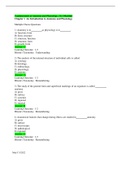Fundamentals of Anatomy and Physiology, 11e (Martini)
Chapter 1 An Introduction to Anatomy and Physiology
Multiple Choice Questions
1) Anatomy is to as physiology is to .
A) function; form
B) form; structure
C) structure; function
D) structure; form
E) growth; form
Answer: C
Learning Outcome: 1-2
Bloom's Taxonomy: Understanding
2) The analysis of the internal structure of individual cells is called
A) cytology.
B) histology.
C) embryology.
D) physiology.
E) anatomy.
Answer: A
Learning Outcome: 1-2
Bloom's Taxonomy: Remembering
3) The study of the general form and superficial markings of an organism is called
anatomy.
A) gross
B) surface
C) systemic
D) regional
E) surgical
Answer: B
Learning Outcome: 1-2
Bloom's Taxonomy: Remembering
4) Anatomical features that change during illness are studied in anatomy.
A) gross
B) surface
C) microscopic
D) pathological
E) regional
Answer: D
Learning Outcome: 1-2
Bloom's Taxonomy: Remembering
Med C ©2022
, 5) The study of the first two months of development is termed
A) histology.
B) embryology.
C) cytology.
D) pathology.
E) organology.
Answer: B
Learning Outcome: 1-2
Bloom's Taxonomy: Remembering
6) The study of the function of specific organ systems is called
A) systemic physiology.
B) organ physiology.
C) cell physiology.
D) pathological physiology.
E) histology.
Answer: A
Learning Outcome: 1-2
Bloom's Taxonomy: Remembering
7) Cardiovascular function is an example of
A) histophysiology.
B) organ physiology.
C) systemic physiology.
D) pathological physiology.
E) physiological chemistry.
Answer: C
Learning Outcome: 1-2
Bloom's Taxonomy: Remembering
8) The study of the liver is to gross anatomy as the study of a liver cell is to
A) physiology.
B) regional anatomy.
C) cytology.
D) systemic anatomy.
E) radiographic anatomy.
Answer: C
Learning Outcome: 1-2
Bloom's Taxonomy: Remembering
Med C ©2022
, 9) Identify the branch of biological science that studies the external and internal structure of the
body and the physical relationship among body parts.
A) genetics
B) physiology
C) embryology
D) anatomy
E) cytology
Answer: D
Learning Outcome: 1-2
Bloom's Taxonomy: Remembering
10) Identify the branch of biological science that deals with the study of how living organisms
perform their vital functions.
A) genetics
B) physiology
C) embryology
D) anatomy
E) cytology
Answer: B
Learning Outcome: 1-2
Bloom's Taxonomy: Remembering
11) The study of the changes in form that occur between conception and physical maturity is
called anatomy.
A) developmental
B) clinical
C) systemic
D) embryological
E) physiological
Answer: A
Learning Outcome: 1-3
Bloom's Taxonomy: Remembering
12) The study of the anatomical organization of specific areas of the body is called
anatomy.
A) gross
B) surface
C) systemic
D) regional
E) clinical
Answer: D
Learning Outcome: 1-2
Bloom's Taxonomy: Remembering
Med C ©2022
, 13) The study of the relationships of the body's structures by examining cross sections of tissues
or organs is called anatomy.
A) gross
B) surface
C) systemic
D) regional
E) sectional
Answer: E
Learning Outcome: 1-2
Bloom's Taxonomy: Remembering
14) Which of the following is arranged in correct order from the most complex to the simplest?
A) cellular, tissue, molecular, system, organ, organism
B) molecular, cellular, tissue, organ, system, organism
C) tissue, cellular, molecular, organ, system, organism
D) organ, organism, molecular, cellular, tissue, system
E) organism, system, organ, tissue, cellular, molecular
Answer: E
Learning Outcome: 1-3
Bloom's Taxonomy: Analyzing
15) Which organ system provides support, protection of soft tissue, mineral storage, and blood
formation?
A) integumentary
B) muscular
C) skeletal
D) nervous
E) endocrine
Answer: C
Learning Outcome: 1-3
Bloom's Taxonomy: Remembering
16) Which organ system transports nutrients, metabolic wastes, gases, and defense cells?
A) cardiovascular
B) digestive
C) muscular
D) respiratory
E) urinary
Answer: A
Learning Outcome: 1-3
Bloom's Taxonomy: Remembering
Med C ©2022





